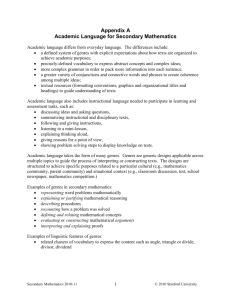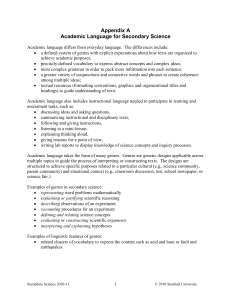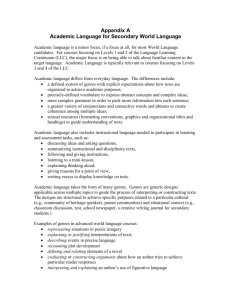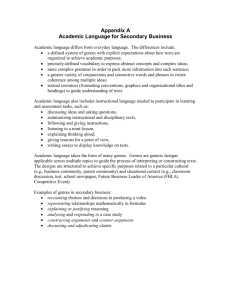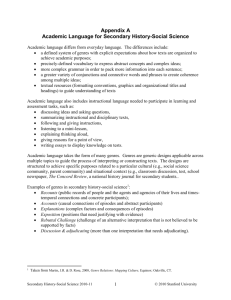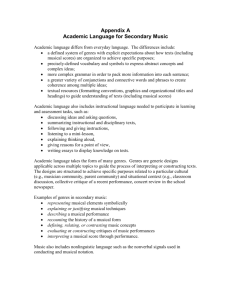Academic Language for Elementary Mathematics
advertisement
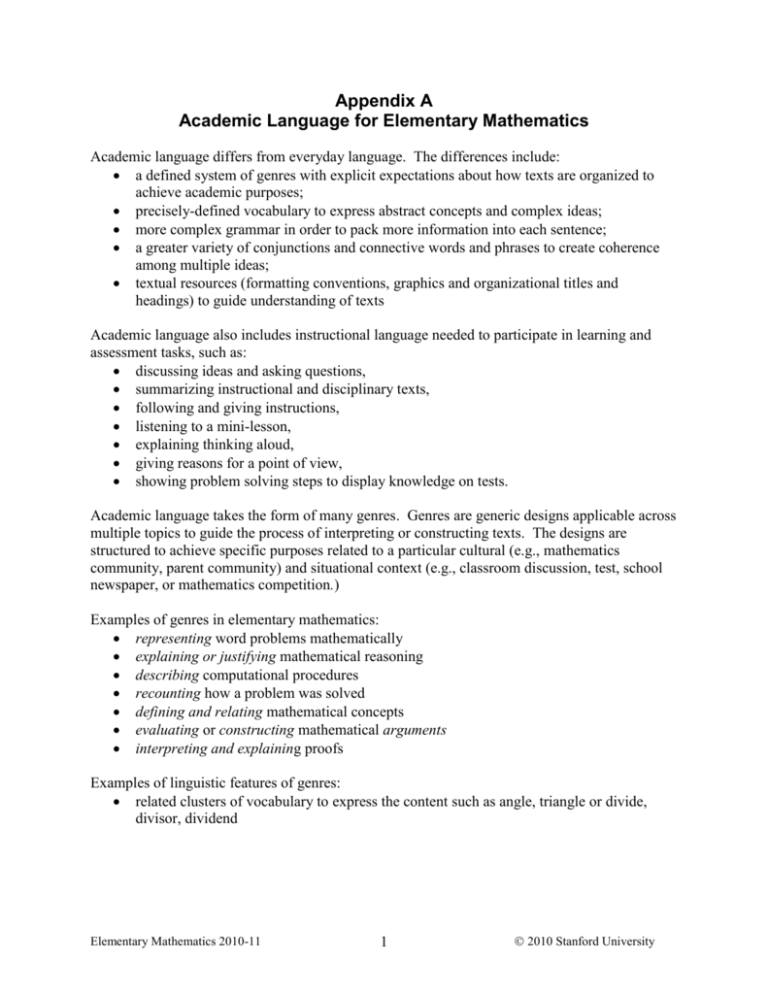
Appendix A Academic Language for Elementary Mathematics Academic language differs from everyday language. The differences include: a defined system of genres with explicit expectations about how texts are organized to achieve academic purposes; precisely-defined vocabulary to express abstract concepts and complex ideas; more complex grammar in order to pack more information into each sentence; a greater variety of conjunctions and connective words and phrases to create coherence among multiple ideas; textual resources (formatting conventions, graphics and organizational titles and headings) to guide understanding of texts Academic language also includes instructional language needed to participate in learning and assessment tasks, such as: discussing ideas and asking questions, summarizing instructional and disciplinary texts, following and giving instructions, listening to a mini-lesson, explaining thinking aloud, giving reasons for a point of view, showing problem solving steps to display knowledge on tests. Academic language takes the form of many genres. Genres are generic designs applicable across multiple topics to guide the process of interpreting or constructing texts. The designs are structured to achieve specific purposes related to a particular cultural (e.g., mathematics community, parent community) and situational context (e.g., classroom discussion, test, school newspaper, or mathematics competition.) Examples of genres in elementary mathematics: representing word problems mathematically explaining or justifying mathematical reasoning describing computational procedures recounting how a problem was solved defining and relating mathematical concepts evaluating or constructing mathematical arguments interpreting and explaining proofs Examples of linguistic features of genres: related clusters of vocabulary to express the content such as angle, triangle or divide, divisor, dividend Elementary Mathematics 2010-11 1 2010 Stanford University connector words that join sentences, clauses, phrases and words in logical relationships of time, cause and effect, comparison, or addition1 cohesive devices that link information in writing and help the text flow and hold together2 grammatical structures such as comparisons (The ___ is longer than the ____.); passive voice, nominalizations where verbs are turned into nouns like add into addition to help condense text and make connections between sentences as in “ I added 2 to 3 to get 5. By this addition, I found the number of books that Susana and Peter had together.” text organization strategies Examples of connector words for different purposes: Temporal: first, next, then Causal: because, since, however, therefore Comparative: rather, instead, also, on the other hand Additive: and, or, furthermore, similarly, while Coordinating: and, nor, but, so Example of text organization strategies for increasingly complex arguments3: • Simple argument: point/proposition, elaboration I added 3 plus 7 because I wanted to find the total number of cookies that Mei Lee and Kevin brought. • Argument with evidence: Proposition, argument, conclusion • Discussion: statement of issue, arguments for, arguments against, recommendation • Elaborated discussion: statement of issue, preview of pro/con, several iterations of point/elaboration representing arguments against, several iterations of point/elaboration representing arguments for, summary, conclusion 1 Knapp, P. and Watkins, M. (2005). Genre, text, grammar: Technologies for teaching and assessing writing. Sydney: University of New South Wales Press, Ltd. p. 49 2 Knapp & Watkins, op. cit., p. 47 3 Adapted from Knapp & Watkins, op. cit., pp. 190-195. Elementary Mathematics 2010-11 2 2010 Stanford University
